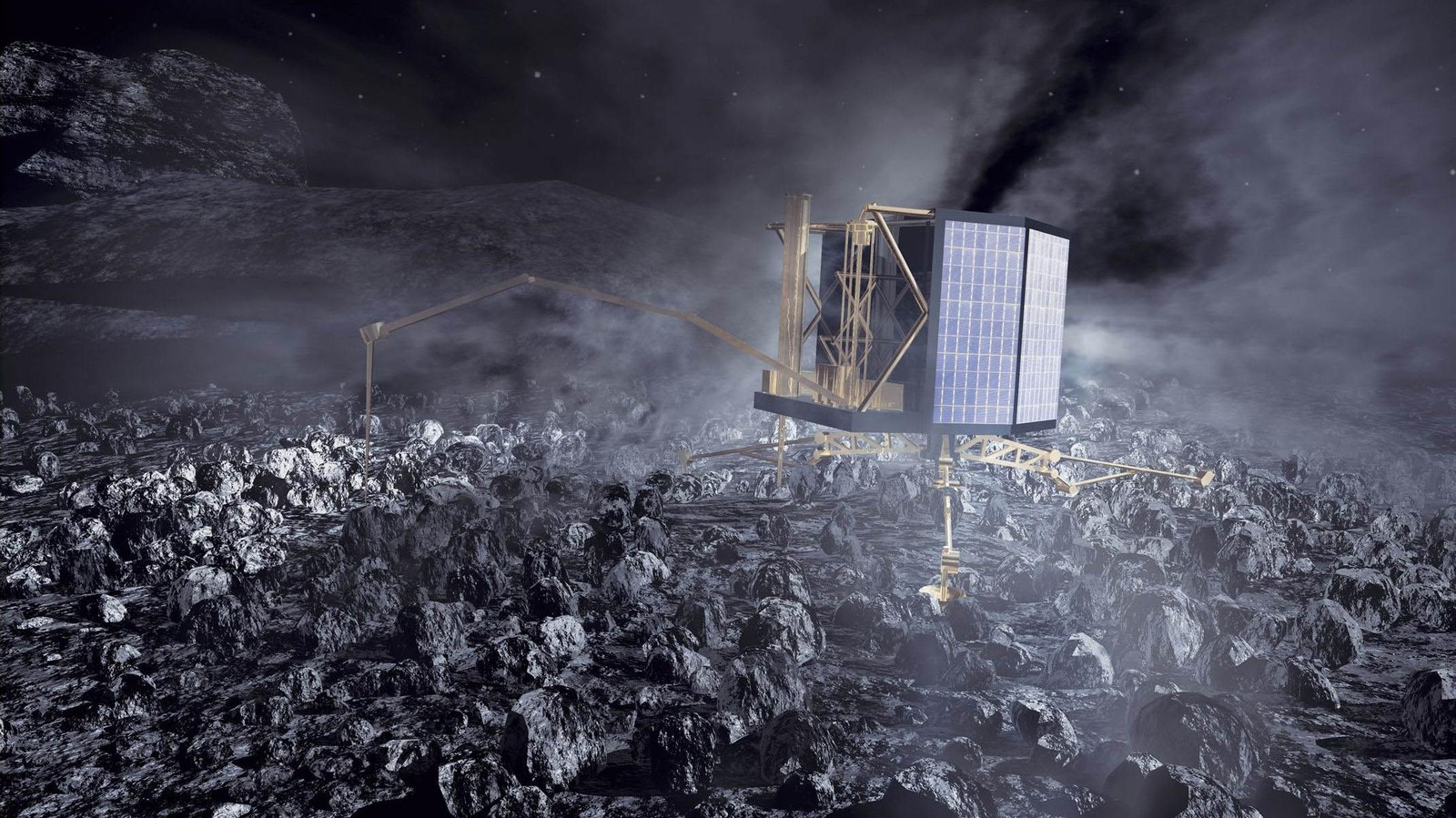Contact with Philae still irregular and unstable

ESA / AOES Medialab.
Despite a new trajectory for Rosetta and a reduction of the distance between the orbiter and Comet 67P/Churyumov-Gerasimenko from 200 to 180 kilometres, contact with the Philae lander remains irregular and short. After the initial contact on 13 June 2015, Philae has reported to the German Aerospace Center (Deutsches Zentrum für Luft- und Raumfahrt; DLR) Lander Control Center (LCC) in Cologne a total of six times. However, for the last three possibilities calculated for establishing a connection with Philae, no data could be received. "Right now, we are playing with the geometry between the Rosetta orbiter and the Philae lander," says DLR's Philae Project Manager, Stephan Ulamec. "The most recent contact – on 24 June 2015 – lasted 20 minutes; then, the line went dead again." Now, the DLR and ESA mission teams are analysing which measures will make better contact with Philae possible.
Communication needs sunlight
Comet 67P/Churyumov-Gerasimenko has a rotation period of 12.4 hours, so a contact should be possible approximately twice per Earth day during an overflight by the Rosetta orbiter. But several conditions must be met before Philae can communicate with Rosetta and its control room in Darmstadt, and then with the LCC. Firstly, Philae must be in operation, and this can only happen when there is sufficient solar illumination for its solar panels to generate the necessary power. In addition, the antennas on the lander and the orbiter must be aligned. The performance of Philae’s antennas is partially affected by objects in the nearby and fairly harsh environment. Also, the Rosetta orbiter needs to align its antenna as closely as possible towards the comet.
Caution on active comets
The Rosetta team has to take other factors into consideration during their flight planning. The increasingly active Comet 67P/Churyumov-Gerasimenko ejects gas and dust particles into space. This already caused a problem in March 2015, when the star trackers on the orbiter incorrectly interpreted dust particles as stars and was unable to determine the orientation of the orbiter. At that time, Rosetta automatically transitioned into 'safe mode' and moved away from the comet; only then could it be controlled by commands from the ground again. For this reason, a closer approach to 67P/Churyumov-Gerasimenko has to take place gradually and under constant observation to confirm whether the orbiter remains unaffected. The trajectory of the orbiter is currently considered to be in a non-hazardous environment for comet outgassing. Rosetta is flying a 'terminator orbit' along the day-night boundary of the comet and passes over Philae in the comet's early morning; at this time, the lander is on – but only just. "At this point, the lander is not optimally illuminated by the Sun," says Ulamec. Overflights at other times on the comet have not been carried out since Philae awoke from hibernation.
Intermittent contacts
Having the orbiter move 20 kilometres closer to the comet does not seem to have improved matters. "There have been multiple contacts during which Philae has sent us information about its status, but these connections were unstable," explains Ulamec. On 19 June, the LCC in Cologne received two two-minute-long connections within 19 minutes. On 20 June, there were again two connections, each of which lasted about one minute. On 23 June, Philae made a 20-second transmission but did not send any data. During the most recent contact on 24 June, the connection lasted 20 minutes but was not stable, so Philae sent a total of 80 data packets. Between contacts, there have been multiple calculated contact times when no connection has been established. Even during the last three overflights by Rosetta – at an altitude of 180 kilometres – there was no contact.
On Saturday, ESA will begin new manoeuvres, which will move the Rosetta orbiter 20 kilometres closer to the comet's surface and Philae by 30 June 2015. The team at the DLR control centre hopes that contact with Philae at a distance of 160 kilometres will then be regular and stable. The next few days will show whether changes in the geometry between the lander and orbiter improves communication with Philae.
Dependent on long and predictable contacts
One possible reason for the lander's current silence could be a failure of Philae's communications equipment caused by poor conditions during hibernation. Analysis of the data received so far by the team at DLR has shown that while one of the communications units is compromised, the other unit has worked thus far without problems. "To continue conducting scientific work with Philae, we rely on long and predictable contact times," says Ulamec. Once Philae can receive and execute extensive command sequences safely, store the measurement data and send it to the ground team, its 10 instruments will be operated again.
The mission
Rosetta is an ESA mission with contributions from its Member States and NASA. Rosetta's Philae lander is contributed by a consortium led by DLR, MPS, CNES and ASI.
